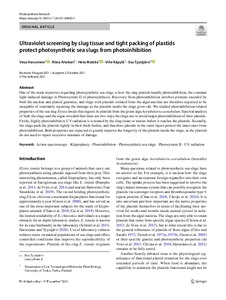Ultraviolet screening by slug tissue and tight packing of plastids protect photosynthetic sea slugs from photoinhibition
Havurinne Vesa; Aitokari Riina; Mattila Heta; Käpylä Ville; Tyystjärvi Esa
https://urn.fi/URN:NBN:fi-fe2022012710793
Tiivistelmä
One of the main mysteries regarding photosynthetic sea slugs is how the slug plastids handle photoinhibition, the constant light-induced damage to Photosystem II of photosynthesis. Recovery from photoinhibition involves proteins encoded by both the nuclear and plastid genomes, and slugs with plastids isolated from the algal nucleus are therefore expected to be incapable of constantly repairing the damage as the plastids inside the slugs grow old. We studied photoinhibition-related properties of the sea slug Elysia timida that ingests its plastids from the green alga Acetabularia acetabulum. Spectral analysis of both the slugs and the algae revealed that there are two ways the slugs use to avoid major photoinhibition of their plastids. Firstly, highly photoinhibitory UV radiation is screened by the slug tissue or mucus before it reaches the plastids. Secondly, the slugs pack the plastids tightly in their thick bodies, and therefore plastids in the outer layers protect the inner ones from photoinhibition. Both properties are expected to greatly improve the longevity of the plastids inside the slugs, as the plastids do not need to repair excessive amounts of damage.
Kokoelmat
- Rinnakkaistallenteet [27094]
